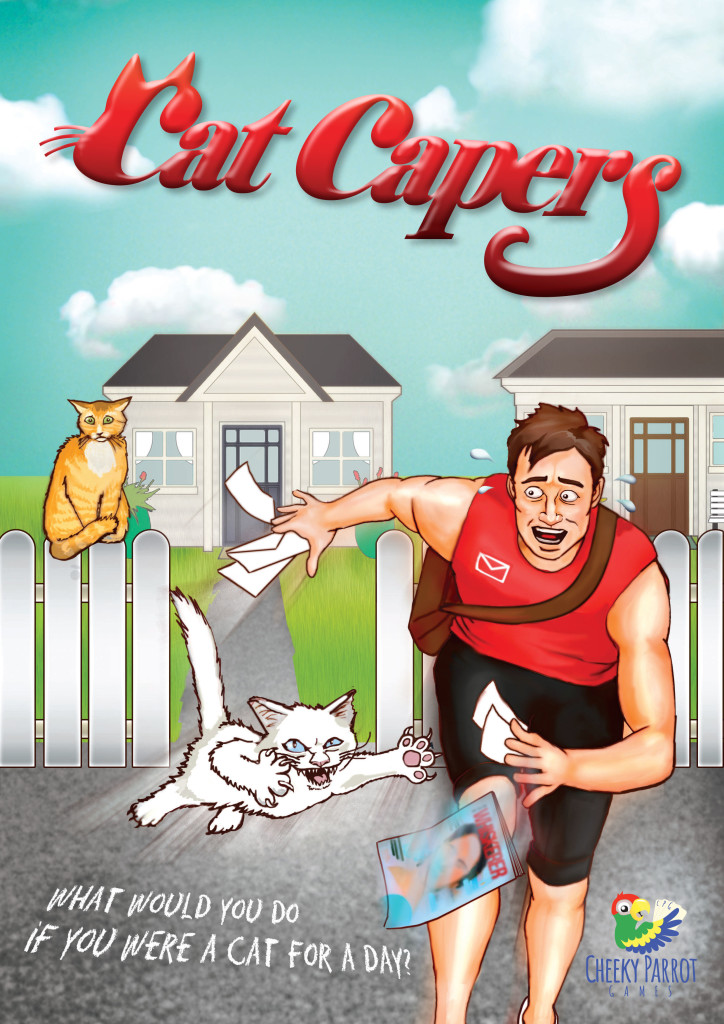I recently had the pleasure of reviewing “Granny Wars” by Cheeky Parrot Games, a game that revolved around players trying to throw points onto their hidden identities in the center of the table without cluing others in as to which color they represented. “Cat Capers” is slightly similar in play style only here, players know which color you are. Rather, players (who assume the role of cats) will be trying to earn points by winning activity cards through a fairly simple bidding mechanic. Once again, I’d like to thank Julia Schiller, Director of Cheeky Parrot Games, for sending me a press copy for review purposes.

Cat Capers: 2-4 Players, Ages 8+, Average Play Time = 30 Minutes
Components
The game includes 4 house tiles, 4 player screens and paw placement trackers, 16 cat paw tokens, 28 activity cards, 36 cat cards, 4 rule player aid, 1 first player marker, and a rule book. There’s also a dog dilemmas reference card that comes with an optional/alternate rule set, complete with dog paw tokens.
Setup & Gameplay
The activity cards are shuffled and dealt face-down evenly among the four house tiles in piles of six (two players use three houses). Leftover cards are placed nearby. The cat cards are shuffled and each player receives four cards to form their starting hand. Each player also gets a screen, tracker, and paw tokens of one color.
The game is played over six rounds, with each round consisting of five phases:
1. Reveal the top activity card on each house.
2. Each player secretly places paws on their own tracker, located behind their screen, indicating which card(s) they want to win.
3. Players reveal their choices and move the paw tokens on the tracker to the corresponding houses.
4. Players resolve challenges. Whoever has the most paws of their color on a house will win the card. Some cards can be played to alter the game or give players advantages, though the color of the card played must match the activity color currently involved in the challenge. You can still play any card face-down regardless of color to add one more paw to the challenge. Ties result in the card being discarded. Capturing cards of your color (matching your screen/paw color) grant you more points (one point for each card).
5. Each player draws one cat card plus one for each paw in their basket (on their tracker). The first player token is passed clockwise and the next round begins.
Once the game is over, players count up their points (remembering to give themselves plus one for each card of their color) and the person with the most, wins!
Editor’s Note: The above doesn’t cover all of the rules found in the manual, but should give you an idea as to how the game is played.
The Review
I liked “Cat Capers” for the same reasons I liked “Granny Wars”…it’s accessible to just about everyone and allows players to play mind games with their opponents, a mechanic I find to be almost irresistible. For example, as the red player, the obvious choice might be to bid on red cards as often as possible so that you can score some extra points via color matching. This can make you somewhat predictable though, so opting to mess with your opponents by bidding on something completely unexpected is also a viable strategy. There’s also some resource management in your cat cards…for example, you could opt to bid a bunch of tokens onto your basket instead of a house so that you can draw a bunch of cat cards at the end of the round. This is especially useful if there a bunch of low valued activity cards you simply don’t care to win, but the extra cards could help you out in a future round.
All in all, “Cat Capers” is family friendly and worth your attention. I just wish it supported five players instead of four. The game goes for about $18.99 (as of 12/15/15), making it a fair deal for what you’re getting here.
Final Verdict: 8/10
—
Purchase: http://catcapers.nz/
—
